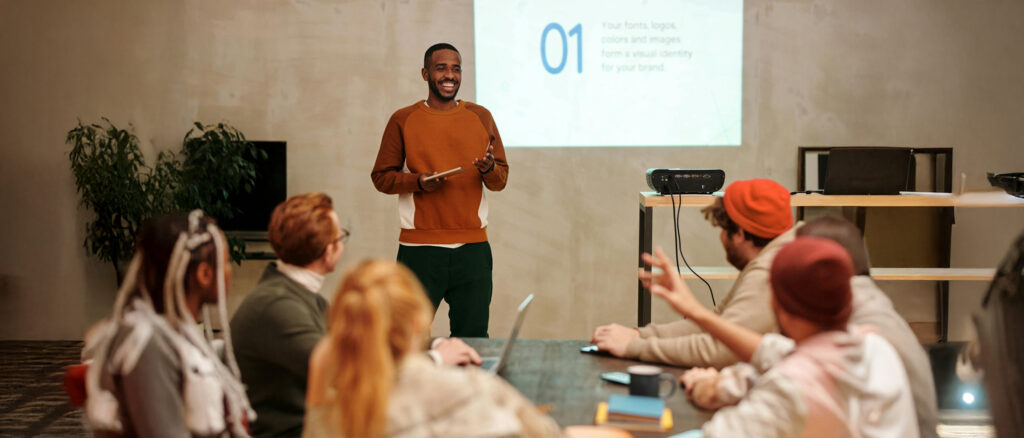Is SEO killing curiosity? And 5 other takeaways from brightonSEO 2024
More and more people are turning to TikTok for search purposes, so your online strategy should focus on creating content that works across various platforms.
Were you at brightonSEO earlier this month? As Sticky’s Director of Editorial, I had a blast presenting to around 600 people on ‘Is SEO killing curiosity?’
We discussed how Google’s the first place we turn when we’re feeling a bit curious. But has having all the answers at our fingertips made things a little too easy? Brands that can successfully pique AND satisfy their audiences’ curiosity will be rewarded with greater engagement and loyalty. I explored how to leverage the Power of Curiosity™️ to create truly effective content.
Were you there? I’d love to know your thoughts. And keep an eye on your inbox as the organisers are sending the video replays out this week.
If you weren’t at the event, don’t worry – you can learn all about Curiosity here. You can also find out your Curiosity type in around 5 minutes via the Curiosity quiz.
Here are some other tips we picked up during the two-day event.
Our top 5 tips from brightonSEO
Tip #1 – Understand the digital generation
On day one of brightonSEO, we heard a lot about Gen Z. We know that many of us are now constantly surrounded by technology and that there’s a whole generation that have never lived without it, but what does this mean for marketers?
According to Yasmin Burchill, brands must make sure their marketing strategy addresses the rise of ‘social search’. More and more people are turning to TikTok for search purposes, so your online strategy should focus on creating content that works across various platforms.
But one thing that did come as a surprise during the talk was that it’s not just Gen Z who are chronically online. When asked to raise our hands if we knew what a Brat Summer was, or if we had heard of the phrase ‘very demure, very mindful’, most of the hands were up, proving that the digital generation doesn’t just consist of a young crowd. It’s a mix of ages, which is something we all need to take into consideration when creating content for online users.
Tip #2 – Stay on-trend with your approach to SEO
In the tech and social space, intelligent search and seamless search experiences are key trends for the future of SEO marketing. Google Lens (which currently has 3bn users a month) and AI are clear examples of these, providing users with content that is more personalised and relevant to their search intent.
As marketers, we want to help Google provide these seamless experiences. But at what cost are we willing to do this? Discussions around ethical SEO practices brought us to another trend: balancing trust. AI may provide scalability of content, but it isn’t always accurate – and Google knows this. So, to gain relevance in the search results, we must continue creating meaningful, human-generated content that provides real value.
To stay on-trend with SEO practices, we as marketers must aim to optimise for experience while adding value, with empathy. Thanks to Claudia O’Shea for her punchy talk on macrotrends.
AI and social search aren’t simply imitations of Google – they’re substantially different and are changing user behaviour accordingly.
Tip #3 – The way people search has changed
When we search in Google, we’re asking more complex questions and expecting more accurate answers. We are happy to give the search engine more details and in return we want more filtered results, rather than us having to sift through topline generic results. This is becoming more achievable as Google and other SERPs can now recognise semantic context and intent behind our searches.
We’re also happier than ever to skip Google altogether and go straight to TikTok and search there, hence the phrase ‘to Google something’ going out of common parlance and being replaced by ‘to search something up’.
Marketers also need to be aware of the new Google AI Overview feature and of ‘zero click searches’ which give the user an answer without them having to click through.
Thanks to Pablo Lopez for a very engaging talk.
Tip #4 – Think beyond Google
One of the themes running through brightonSEO was that Google is no longer the only search engine game in town. Or at least, other channels are starting to make inroads on what appeared until recently to be its unassailable supremacy.
Several speakers mentioned search engine challengers but Nathan Height made diversifying beyond Google the theme of his talk. Perplexity got a namecheck, as well as ChatGPT, the prototype SearchGPT, and TikTok as alternative platforms. But it was also interesting to understand more of the background to the challenges to Google, namely antitrust cases against the search giant in the US and the EU.
The overall takeaways are that AI and social search aren’t simply imitations of Google – they’re substantially different and are changing user behaviour accordingly. And that a landscape that seemed set in stone is now undergoing what could be a seismic shift. As content creators, we need to stay ahead.
Tip #5 – Use AI to test the relevance of your ideas
Many of us use generative AI to come up with creative ideas, but few of us use it to test ideas of our own. Sophie Coley’s talk on producing relevant content suggested using Perplexity to do exactly that. It all starts by writing a prompt asking to create personas, each of which should be based on a unique reason for buying or a unique barrier to purchase.
The prompt should also ask for a statement from each persona explaining their day-to-day, why they’d buy a chosen product and what’s great or difficult about that process. The few sentences are designed to guide content creators during the ideation process. Genius! And smartest of all, thanks to the platform’s ‘memory’, copywriters, strategists and designers can run questions by the generated personas.
So many takeaways from a brilliant two days in Brighton. We’re looking forward to helping our clients apply these learnings to inform their SEO strategies. And we’re looking forward to next year as well! See you there.
To learn more about Curiosity™, get in touch.

Carla Dobson-Elliott
Director of Editorial Content



